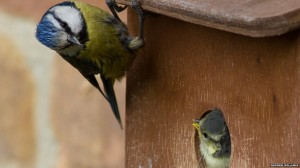Week 19 – 20 November 2016:
When Bigger is Better
The differences in nest architecture among bird species are remarkable. At one end are the nests of Killdeer, constituting no more than a few bits of gravel scraped into a circle around a slight depression in the ground. At the other end are the gigantic nests of some raptors that grow in size with the passing years as the resident pair adds more and more material.
As with so many things in life, nests represent a tradeoff for the birds constructing them. More time and effort spent on building the perfect nest might result in better survival of the eggs and chicks, but this could come at the expense of time not spent in self-maintenance and foraging. Biologists are interested in how individuals resolve such tradeoffs. What is the optimal solution? Which alternative will result in the greatest lifetime reproductive success?
Michał Glądalski and his colleagues at University of Łódź in Poland are involved in a long-term study of birds utilizing artificial wooden boxes for nesting. Since 2012, Glądalski and his crew have been studying Great and Blue tits nesting in boxes in two habitats in central Poland. A mature deciduous forest contains 300 nest boxes, while a parkland site with fragmented tree cover has 200 boxes. To these nest boxes, tits add moss and dry grass to complete an outer structural component, and hair and feathers as an inner lining. As measures of reproductive success, the number of eggs in the nest, the proportion of eggs that hatched, and the proportion of hatchlings that eventually fledged from the nest were all documented.
Compared to most songbirds, tits lay a lot of eggs. The average clutch size of Blue Tits varied between ten and thirteen; Great Tit clutch sizes averaged between eight and eleven. Nests constructed within boxes by Blue Tits were considerably larger and heavier than those of Great Tits. Nests did not differ significantly between the two habitat types.
The key finding of the study was that, in general, the greater the mass of the nest lining, the greater the reproductive performance of the parents. Overall nest size and mass was also important. In tits, the nest serves to help maintain an optimal warm and humid environment for the eggs and young nestlings. Where nests are concerned, bigger appears to be better.
Or so it would seem. Studies to date have not fully disentangled the relationship. Nests characteristics alone may not explain everything. It is possible that parents that are more experienced or in better physical condition are able to construct better nests, but are also better able to care for their eggs and chicks. Is nest size the crucial factor, or is it the effort made by the parents? “Future experimental studies… should at least try to efficiently separate these two factors,” wrote Glądalski et al.
It is possible for a researcher to become so focused one particular aspect of their topic that the “bigger picture” is lost. Glądalski and his team are considering the lives of birds utilizing nest boxes in Poland from many different perspectives. When I contacted him, Glądalski explained that he and members of his group are considering breeding success, physiological stress, the influences of heavy metals, variation in egg size, and the genetics of individuals in their population. Glądalski is particularly interested in the ways that global climate change might influence the timing of reproduction and nest characteristics. I suspect that this sort of comprehensive approach is likely to result in a more profound understanding of bird biology in the long term.
Glądalski, M., et al. 2016. Effects of nest characteristics on reproductive performance in Blue Tits Cyanistes caeruleus and Great Tits Parus major. Avian Biology Research 9:37-43.
Photo credits: Blue tit coaxing a chick to fledge, photo by Andrew Williams - www.bbc.co.uk/nature/21445671; Great tit and chicks - www.audubon.org/news/build-nest-box-welcome-spring-birds



